By Donald H. Harrison
San Diego, CA (special) -- Detectives have a saying in criminal investigations:
"follow the
money." But this inquiry deals with how love developed between two
Jewish communities widely
separated in time and in place. The key to this investigation is to
"follow the Torah."
We begin our tale in 1983, shortly after a new Conservative Congregation
Beth Am was
established in a former tire store in Solana
Beach, California.
Rabbi Wayne Dosick, who was the the congregation's spiritual leader,
learned that Westminster
Synagogue in
England had approved Beth Am's application to receive one of the Holocaust
Torahs held in trust for the Jewish people.
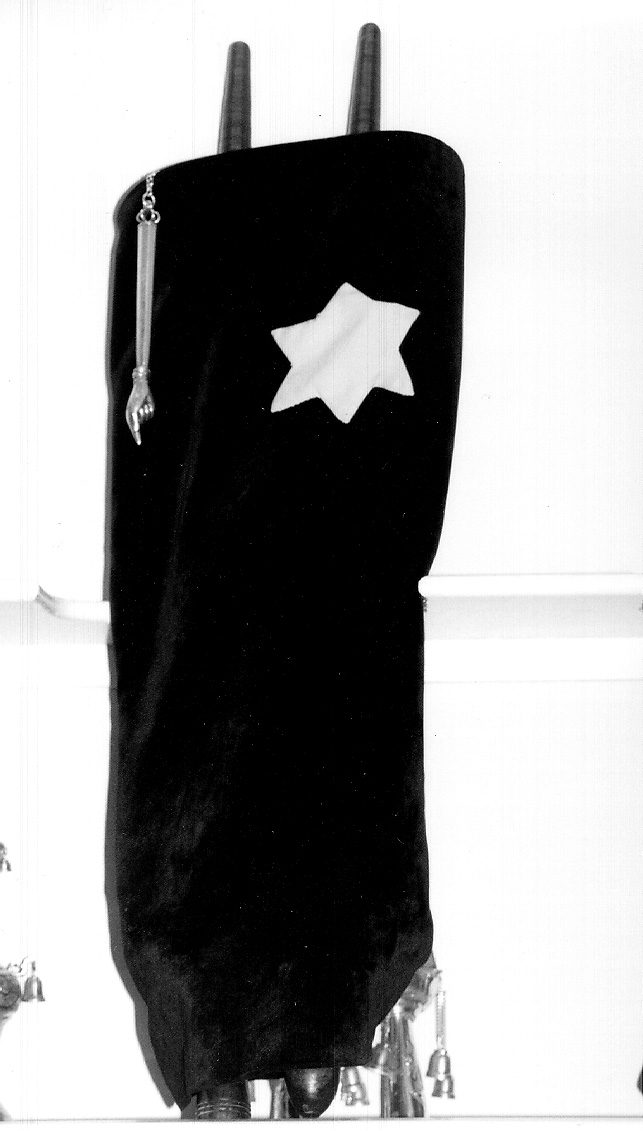 |
Following the defeat of nazi Germany
in World War II, Westminster Synagogue became the custodian of 1,564 Torahs
which had been looted from the synagogues of central Europe. These precious
legacies had been stored in Prague with the intention of some day creating
a museum to an extinct people -- an exhibit the nazis had hoped would justify
the genocide they committed against the Jews.
After Czechoslovakia
was reestablished as an independent country, agreement was reached for
the Torahs -- all carefully numbered by the nazi looters -- to be turned
over to Westminster Synagogue and from there to be returned, one by one,
into the active service of the Jewish people.
Congregation Beth Am was not the first synagogue in San Diego |
| Holocaust Torah |
County to obtain a Holocaust Torah, nor would it be the last. But no where
to date has a Holocaust Torah weaved a more wondrous spell than it did
with this congregation.
There were certain fees and shipping costs associated with transporting
this Holocaust Torah
from the Westminster Synagogue to the United States. Dosick, today
leader of the Elijah
Minyan
in Carlsbad and a successful
author of numerous Jewish-themed books, recalled that the total
was somewhere between $1,500 and $2,000, money that simply was not
within the new
congregation's budget.
"I called up a person immediately whom I knew bringing a Holocaust Torah
would mean the
most to -- Lynn Schenk -- because of her parents (Sidney and Elsa Schenk)
being survivors,"
Dosick recalled. "I told her the story and there was a check on my
desk the next day."
At the time, Schenk was working as an attorney. She later gained civic
recognition as a
commissioner for the San Diego Unified Port District, and later as
a Democratic member of
Congress. Today she serves as the chief of staff for California Gov.
Gray Davis. Both she and
her brother, attorney Fred Schenk, along with their families, belong
to Congregation Beth Am.
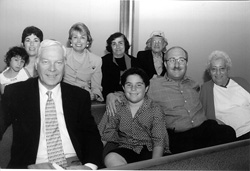 |
At dedication ceremonies on Sunday, June 13, for Congregation
Beth Am's new synagogue
complex in the Carmel Valley section of San Diego, Schenk told a large
audience that when
Rabbi Dosick asked her and her husband, Hugh Friedman, to make the
special donation, the,
rabbi in fact, had conferred upon them "a rare privilege."
"Our Torah in many ways became the foundation of all that was to come,"
she said. "It organized |
| Schenk Family |
us as a congregation and became the symbolic link to our collective roots."
Dosick recalled that when the Torah arrived at the U.S. Customs facility
at San Diego's
Lindbergh Field, "it came in a long, narrow box, and there I was. I
had more hair and more
beard in those days, and the guy thought- I'm sure--that we must have
been trying to smuggle
drugs or something, because he made me open the entire box, then the
entire Torah and roll it
out, so he could see indeed that it was a sacred scroll."
While giving the Torah such a close inspection, Dosick noticed the number
747 on it. Being at an
airport, one might have associated this number with Boeing-747s, the
large jumbo aircraft. But
this was the nazi catalogue number. And there was a bittersweet irony
to that number- 747. For
if you add the three integers, 7, 4, and 7, they total 18 -- the number
associated with the Hebrew
word, chai, meaning "life."
(Before the use of Arabic numerals became commonplace around the world,
Hebrew speakers used their alphabet as numbers. Alef was 1; Bet was 2,
Gimel was 3, and so forth. One could add the value of each letter to obtain
the value of the word. The word chai is spelled Chet-Yud.
Chet has the value of 8. Yud has the value of 10.)
So here was a Torah, once bound for a museum of extinction, now headed
for a new life in the
United States!
Along with the catalogue number was a notation that the Torah once had
been housed in the
synagogue of
Roudnice, Czechoslovakia, a town lying on the River Labem (known in
German as
the River Elbe), about 25 miles north of Prague.
Roudnice is pronounced Rude-Nietzsche, which is a coincidental, but
perhaps apt, description of
the philosophy of German philosopher Frederic Nietzshe, who believed
power was the chief
motivating force of societies and people.
After returning from the airport, Dosick went to his Encyclopaedia Judaica
to learn more about Roudnice. It reported that "23 Jewish families were
known to have lived there in 1570, but community must have existed there
before." The entry went on to say that the original homes and cemetery
were abandoned to make room for a monastery, and that in 1631, the Jewish
community (which had moved elsewhere in the town) "saved the town from
destruction by the Saxons by paying a large sum of money."
There was a massacre of some Jews in Roudnice in 1744, at the same time
that Jews were
expelled from Prague. A new synagogue was built in 1853, and another
cemetery established in
1896. In 1930, the community numbered about 136 Jews or about 1.7 percent
of the
population.
Then the entry in the Encyclopaedia Judaica reported: "When the community
was liquidated by
the nazis in 1942, its synagogue equipment was sent to the central
Jewish Museum in Prague. No
congregation was reestablished after World War II. Richard Feder served
as rabbi of Roudnice."
So, the Torah had been out of service since 1942, and now in 1983 it
was coming back. Like
Moses and the Israelites, it had been in the desert for some 40 years!
The Encyclopaedia Judaica also sketched the life of Rabbi Feder, who
was born in 1875 and
who was graduated from a rabbinical seminary in Vienna. Feder was an
author. In 1919, he
wrote a book Jews and Christians, and in 1923, he developed
a textbook on the Hebrew
language.
He was based in the town of Kojetin, but also conducted regular services
in the nearby villages
of Roudnice, Kolin, and Louny, before nazis arrested him and sent him
to the concentration camp
at Theresienstadt,
where he continued to serve as a rabbi. He survived the war and eventually
resettled in Brno, where he was designated as chief rabbi of the Czech
province of Moravia. In
1961, he added to his portfolio service as the chief rabbi of the province
of Bohemia, in which
Roudnice is located.
Feder went on to write in 1947 Jewish Tragedy, one of the first
books published on the
Holocaust. He several times updated Jewish Tales, a collection
of stories for children. In 1955
he published Jews and Judaism, and in 1955 wrote Sinai, a textbook
of religious instruction. In
1965, the communist government of Czechoslovakia gave Feder a medal
for his "uncompromising stand in the fight against fascism" and for his
efforts in behalf of peace. The rabbi died in 1970 at the age of 95 --
a full life.
Dosick designed a mantle to dress the Torah in --one which is hauntingly
beautiful in its
starkness. The mantle, still used today, is of pure black with a yellow
cloth star -- similar to the
stars that the nazis had forced their Jewish victims to wear as identification
on their clothing.
On Yom Kippur Day, 1983, the Torah ceremonially was brought under a
chuppah into the
synagogue, in what Lynn Schenk later would describe as an "electrifying
High Holy Day service."
"There under the chuppah: one survivor, my father, clutching another
survivor, our Torah,"
Schenk recalled, as the emotion crept back in her voice. "It was a
moment that I don't think
anyone will ever forget who had the privilege of sharing that. Each
person who was gripped with
emotion, young or old, we thought our own thoughts of family, of heritage,
of six million lost."
Dosick recalled that Schenk told him following that High Holy Day procession
"that while we
were standing there waiting to come in, her father told her for the
first time in her life that his job
in the camps was to make the yellow star. " The mantle had triggered
his memory, "so for the first
time in her whole life, she learned from her father that had been his
job in the concentration
camp."
After the service, Dosick remembered, he was approached by congregant
Nellie Katsell, who
told of being born to survivors after liberation and living in Czechoslovakia.
Rabbi Feder travelled
throughout Czechoslovakia after the war and often had stayed with her
parents when he visited
their community, she told the rabbi. So, here was a connection: "Not
only did we have a picture
of the man (Feder) who had read from the Torah, we had a live witness
to his life and work,"
Dosick exulted.
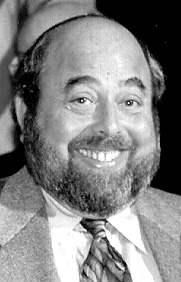 |
After the ceremony Dosick decided that the Torah should
not simply be put into a ceremonial case in the synagogue, nor its use
limited to special occasions like the annual Yom HaShoah
observance.
Halacha, or Jewish law, dictates that every word of the Torah
be perfectly legible, and that the scroll be repaired of all blemishes,
because the Torah is the word of God. Only a perfect copy of the Torah
is considered eligible for reading. Damaged Torahs either are buried like
a human being, or kept for exhibits.
"That it could be a living memorial and not a museum piece, I had to
make a really serious halachic decision," Dosick said. "The Torah
was nowhere near a kosher Torah, and it would
have taken many thousands of dollars, probably $10,000 - $15,000, to
make it kosher again.Even then, a sofer who |
| Rabbi Wayne Dosick |
looked at it wasn't quite sure it could be done without harming it.
"I had to make a decision that I thought God would rather have the bar/
bat mitzvah child read
from a not-quite-kosher Torah, but make it a living memorial," Dosick
said.
"I have written more than once that we Jews are good at saying kaddish
, but not so good at
saying hallel -- that we are good at crying but not so good at rejoicing,"
the rabbi-author said. "I
wanted us to have both messages: 'We do not forget those children who
didn't live to stand at the
Torah' and at the same time 'We celebrate that a new generation of
Jewish children is standing at
the Torah and is celebrating bar/bat mitzvah and is triumphing over
evil and serving God.'"
And so, Dosick began Congregation Beth Am's tradition of having every
bar/ bat mitzvah child
read at the ceremony from the Holocaust Torah. "I always said that
they not only came to the
Torah for themselves but also for one of the little children of Roudnice
who would have liked to
have come to Torah for his bar mitzvah but whose life ended instead
in a puff of smoke from a
crematorium chimney."
He repeated that lesson week after week, year after year, until he left
Congregation Beth Am in
1991, and "after a certain time the kids began to tease me about it,
as they will, because if you
hear something 30 times a year, sometimes it becomes a parody of itself,"
Dosick said.
Nevertheless, the message had staying power. One example was when "one
of the families from
the shul went back to Illinois and asked me a few years later to officiate
there at their kid's bar
mitzvah, and even though they did not have a Holocaust Torah, they
asked me to tell that story."
* * *
Other congregants who remembered the story were Carol Davidson Baird,
who in 1989 was
president of the San Diego Jewish Genealogical Society; her husband
Dr. Stephen Baird, their
children Daniel and Geoffrey Baird, and her parents, Ernest and Eva
Davidson, who were
Holocaust survivors.
The Bairds and Davidsons decided to go on a genealogical trip to trace
their roots-- a trip which
took them to the Davidsons' native Germany
and
also to Poland, Czechoslovakia and Hungary.
After the families arrived in two rental cars in Czechoslovakia, they
had intended to spend a day
sightseeing in Prague, but political unrest there- associated with
protests against the state during
the dusk of the Communist system--persuaded them to head instead for
the Theresienstadt
Concentration Camp, also known in the Czech language as Terezin.
"Wayne Dosick was always talking about the Torah in human terms, so
we decided to go see the
town where it came from" en route to Theresienstadt, Carol Baird recalled.
Using her training as a genealogist, Baird suggested to her German speaking
mother that they
stop in the center of Roudnice and "find the oldest person, who probably
would speak German,
and ask where the synagogue was.
"So we did that," Baird related. "Mom talked to this old lady in German,
who gave her very
interesting directions, which we followed up the street, and there
was nothing there, just a vacant
lot. I figured maybe that was where the synagogue was destroyed. Across
the street my husband
said to 'look at that building; it is now a school but it sure looks
like all the other synagogues that
we have seen in Europe.' So we took pictures of it as well."
Not being certain that was the synagogue, the family kept walking down
the street and eventually
came to a police station. These were the Communist times and officialdom
was none to friendly
to Americans. "But we went into the police station and asked two of
the policemen if they knew
where the synagogue was. They just laughed, really snidely, at us,
and said 'Synagogue Kaput!'
We left thinking we were very lucky to be able to leave."
Nevertheless, the family continued to walk around the town, and just
as they were ready to
leave, they saw a woman admiring one of their German rental cars. They
asked her about the
synagogue, and she replied that although she didn't know where it was,
perhaps some of the
ladies in the nearby beauty parlor might She went in and conferred
and "all of a sudden a gaggle
of old women came out, all talking and pointing in different directions
where the old synagogue
was us," Baird said.
The lady reported what the consensus was, and then offered to accompany
the American
strangers to the site. She gave her purse to her husband before climbing
into the car with the
Davidsons, who drove in front as the Bairds followed. They drove out
of town and stopped
momentarily at a Catholic cemetery where men were seated on a bench
surrounding a tree. The
woman got out to confer with the men, while the Davidsons and the Bairds,
misunderstanding
what was happening, started to explain that they were looking for a
Jewish cemetery, not a
Catholic one. The woman said she understood but just wanted to ascertain
the directions. The
men told her to follow the dirt road.
"We continue further until the road ends and there is no place to go,"
Baird related. "On one side
is an open field, on the left side is an enormous forest. We all get
out of the car and she points to
go through the forest. There is a broken wall. We climb over that....
"We ducked under the branch of a tree and it was the most extraordinary
sensation. We all got
goose bumps. There was a building with a big Jewish star, which we
thought was the destroyed
synagogue. We went out and started tracing (putting a piece of paper
over inscriptions, and
penciling over the paper to copy the impression)."
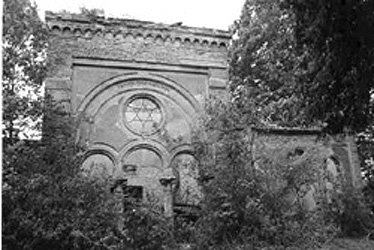 |
Meanwhile the Bairds' two sons started exploring the dome
roof that had fallen into the center of the burned structure. "Geoffrey
found a burnt timber from the roof, and Danny found a block from the wall
itself where the stucco had come off," Carol Baird said. "We kept that,
and I started taking pictures of the other buildings--the attached buildings
that had Hebrew writing on the walls." |
| Roudnice Ceremonial Hall {photo
by Carol Davidson Baird} |
After returning to the United States, the Bairds learned through research
that the building that
they thought had been the synagogue in actuality was a ceremonial building
located adjacent to a
Jewish cemetery on the outskirts of town. The inscriptions were psalms
said for the dead. In this
building, bodies had been watched and washed before burial.
The Davidsons and Bairds reunited the lady with her husband (and her
purse), and "drove out of
town feeling very satisfied that we had accomplished our mission,"
Baird said. "That was an
incredibly friendly and wonderful thing for her to do."
The next adventure was getting the pieces of wood and stone from Czechoslovakia
to the United
States. There was the chance unfriendly Czech authorities might consider
the wood and stone to
be valuable historic items--rather than simply sentimental ones--and
accuse the Americans of
attempting to steal treasures. Son Geoffrey wrapped the souvenirs in
his dirty laundry and put
them in the bottom of the suitcase. "When we left Czechoslovakia, they
did search a lot of stuff
but they didn't bother with that," Baird said.
Upon return to the United States, Baird had her photograph of the ceremonial
building printed
and framed. She presented it to the synagogue, along with the wood
and stone, which Dosick
had mounted in a shadow box. The photograph and the shadow box were
dedicated on Yom
Kippur of 1989, and given a place on the wall alongside the bima of
the shul in Solana Beach.
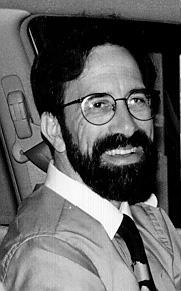 |
The congregation hired its present spiritual leader, Rabbi
Arthur Zuckerman, in 1992, a year in which he recalled there were eight
b'nai mitzvah students who read from the Holocaust Torah.
The congregation has grown so dramatically that 55 b'nai mitzvah students
will read from it this year, "and next year, God willing, 70 students will
be bar and bat mitzvah and they each will have a chance to read from it,"
Zuckerman said.
The congregation's current president, Candice Fagan, quoted Baird at
the recent dedication ceremonies: "Torahs are not just pieces of parchment
wrapped in velvet. Aside from the words
that they contain, they have a history and a story to tell.
"Certainly our Holocaust Torah could tell us of Shabbas mornings in
Roudnice when congregants fondly kissed it and |
| Rabbi Arthur Zuckerman |
children read their maftir from it. The Torah could also tell us of vicious
abduction by the nazis and its loneliness sitting catalogued in a dark
warehouse until the end of World War II ... Our Torah had a life long age.
It was lost, and then found, and reborn in our synagogue. We give life
to the Torah and it in turn gives us words to live by."
Fagan noted that the photograph and effects brought back by the Baird
and Davidson families
inspired architect Michael Witkin "to make his own excursion to Roudnice
and he came back
very inspired to create this beautiful synagogue.
"One of the features of our new home is the Wall of Remembrance," Fagan
said. "Our architect
painstakingly recreated this wall from what he found of what remained
of a once flourishing
Jewish community. When our generation and future generations view this
wall, we will be
reconnected to the past and thrust forward to our responsibility as
Jews in the future."
* * *
The Wall of Remembrance replicates the facade of the ceremonial house
that the Davidsons and
Bairds found that day in the woods. It still was being designed by
Witkin last year when Milos
Pojar, a former ambassador of the new Czech Republic to
Israel, visited San Diego with other
Eastern Europeans on a study tour sponsored by the American
Jewish Committee. Pojar
(pronounced Po-yar) today is director for education and culture of
the Jewish Museum in
Prague.
One of the advantages of being a journalist is the occasional ability
to help make connections
between the people that you meet in the course of gathering stories.
After sitting in on the AJC
conference on border problems, I told Pojar about several Holocaust
Torahs that were located
in our community, including the one at Congregation Beth Am. I also
told him that Congregation
Beth Am, inspired by the origins of its Torah, had in fact developed
an architectural design
invoking Roudnice.
A meeting was arranged between Pojar, Rabbi Zuckerman and the architect
Witkin at the
Holiday Inn at Mission Valley, where the AJC conference had been held.
Witkin told Pojar that after he found the ritual hall he made architectural
sketches and also took
molds of the building. He explained then that the re-creation of the
ritual hall's facade would
provide an entranceway to the new Beth Am complex. Some of the architectural
elements of the
ritual hall, especially its columns, would be repeated in the design
of the overall synagogue, which
would occupy 25,000 square feet.
The architect also told Pojar that his own son recently had read from
the Holocaust Torah for his
bar mitzvah. "That is really what we are doing, honoring children and
connecting us to our past,"
Witkin said.
Pojar's own father had been forced by the nazis to work in the Prague
museum cataloguing
Jewish ceremonial objects looted from the synagogues. The father specialized
in examining and
classifying textiles, but it is possible he could have come into contact
with the very same Torah.
When Pojar returned to the Czech Republic, he did some research on Roudnice
-- research he
shared with members of Congregation Beth Am during the dedication ceremonies,
so that they
could know more about the original home of their Torah.
In the 14th Century the town was considered quite important, because
it was where the Roman
Catholic Archbishop Arnost of Pardubice made his headquarters. This
archbishop, who had
responsibility for all of Bohemia, was a close friend of Charles IV,
emperor of the Holy Roman
Empire, which included Bohemia. Charles IV often visited his friend
the archbishop in Roudnice.
Another visitor was the Italian poet Petrarca.
Jews were "relatively well protected" during Charles IV's time when
they were advisors to the
emperor, Pojar said. But after he died, there was a pogrom in the Prague
Ghetto, which may also
have affected the Jews of Roudnice.
In the 17th century, he reported, Czech Catholics became rulers of the
town and all the farms,
forests and lands around. The leader of this family, Polyxena of Lobkovic,
"ordered Jews to
remove from their ghetto, from the Jewish quarter and go close to the
river, close to the bridge,
to set up a new ghetto there. On the spot where the (first) Jewish
quarter was, and the first
synagogue and the first cemetery were, everything was demolished."
A monastery was built in the
ghetto's place.
It was in the new ghetto, founded in 1630-1640, that there were "approximately
15-20 small
houses around one street, with some yards, where Jews lived until the
beginning of the Second
World War," Pojar reported. "And in this street is located, in fact,
the third synagogue which was
founded in 1822 and which exists, but which is closed, which is empty.
In 1952 it was
transformed into an apartment house and afterwards to a school." Apparently
it was the building,
the Bairds and Davidsons had seen when they first arrived in Roudnice
but had not recognized as
a synagogue.
There are today two Jewish cemeteries in Roudnice. The older one was
established when the
ghetto was moved in the 17th century. Apparently some tombstones had
been transferred there
from the original cemetery because at least one bore the date of 1611,
Pojar said. "This cemetery
was closed in 1890 and now there is a new wall constructed around,
and no one can go in, and
all the tombstones, all the gravestones are intact. ... Only there
are a lot of trees and bushes and
grass; it is almost not possible to see anything there. But nevertheless,
it is only a question of
cleaning it and it would be a nice cemetery."
The third cemetery--or the second one still existing--was built around
1890, and this is the one
where the Davidsons and Bairds found the burial hall in ruins and which
inspired Witkin's design.
"The walls around are also in ruins and the same the tombs," said Pojar.
"It is very sad. It
happened partially during the nazi time, partially during the Communist
time, partially because of
some vandalism."
Pojar noted that the Jews of Roudnice, along with 80,000 other Jews
from Bohemia, Moravia
and Silesia, died in the Holocaust. Among the Czech victims was Pojar's
grandmother Berta
Popperova, who was sent first to Theresienstadt and later to Treblinka
in Poland, where she was
murdered.
In his research, Pojar located the names of 78 Jewish men and women
from Roudnice who died
in various nazi concentration camps, including some whom he memorialized
by setting down small
stones at Treblinka.
The Treblinka victims from Roudnice were Berta and Gisela Freund, Eleanora
Sabat, Salomon
Schreiber and Oskar Taussig, he said. They too might have read from
the Torah or touched it
with their prayer books.
* * *
The Holocaust Torah is now in a new Ark, in a new sanctuary which people
reach by walking
through a courtyard featuring the Roudnice-inspired Wall of Remembrance.
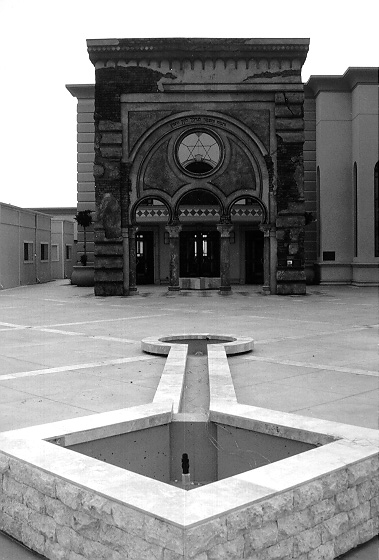 |
But much of the story woven around the Holocaust Torah
remains to be learned and told. Stan Schwartz, owner of Schwartz Judaica
and president of the Jewish
Historical Society of San Diego, is researching which of Rabbi Feder's
books are still in print. He reported that the libraries at the University
of California at Berkeley and the Jewish Theological Seminary of New York
each have at least one of Feder's works.
And Alberto Attia, a San Diego sofer to whom the Holocaust Torah recently
was taken for inspection and some minor repairs (the major repairs still
need to be done), still is pondering an
amazing mystery.
At the same time that he was examining the Holocaust Torah, |
| Beth Am's Wall of Remembrance |
he also was examining another Torah that was owned by Congregation Beth
Tefilah, which since then has merged with Adat Ami Synagogue to become
Ohr Shalom Synagogue.
Attia was amazed that the very distinctive handwriting that formed the
Hebrew letters of the
Holocaust Torah seemed to be the same handwriting that also formed
the letters of the Torah
owned now by Ohr Shalom.
Whereas the Holocaust Torah had come to Congregation Beth Am via Westminster
Synagogue,
the provenance of Ohr Shalom's Torah is unknown. Shelly Berman, a past
president of Beth
Tefilah, believes it may have been purchased from a dealer in New York,
but where the dealer
obtained it is unknown.
Attia is certain that the two Torahs were written by the same unknown
person. "The sofer had a
very distinct writing style," he said. "You can tell the signature
of a sofer by his writing style. Like
in English, there are no two people who write alike -- even if it is
a square block print letter. It
was very distinct, the way in which he wrote."
Pojar made two suggestions for continuing the Saga of the Holocaust
Torah during his speech at
the synaogue building's dedication:
"Jews in Roudnice are unfortunately forgotten, not here but in the Czech
Republic," he told the
congregants.
Pojar said that the present-day Count Lobkovic is an American citizen,
to whom the Czech
Republic has restored the castle after its confiscation by the nazis
and the communists. He
suggested that Congregation Beth Am in cooperation with Prague's Jewish
Museum, the Terezin
Foundation and Lobkovic help to establish in the castle a museum, with
"one or two rooms
commemorating Jews in Roudnice, keeping their past in the memory and
to show the Czech
population that (Jews) contributed for generations, for centuries,
to the grooming of the city,
crafts, industry, agriculture and so on."
The Czech visitor also told the congregation that Tana Fiser and Milos
Dobias are Czech citizens
who created a music and poetry program based on poems of children who
perished in Terezin.
The musicians will be bringing their program to the United States in
the fall and "you might think
of inviting them to your congregation," he said. Fiser, who is Jewish,
is a close friend of the Czech
Republic's President Vaclav Havel, he added, while Dobias is a "famous
musician and
composer."
Former Congresswoman Schenk, who followed Pojar to the podium, commented
"thank you for
bringing to us this wonderful challenge which I am confident that my
fellow congregants are going
to meet." Zuckerman later also endorsed the ideas.
And so the saga of the Holocaust Torah continues.
|


